Introduction
In this lesson we will be exploring how to build up and develop your improvisation from scratch. We’re going to start really simple, as a complete beginner might start improvising, and slowly build up to something much more complex and interesting. Our goal is create an improvisation that sounds complex but that is conceptually quite simple. So it’s easy to think about and implement but nevertheless sounds intriguing. So we’ll start with a very simple base and gradually add more and more layers of complexity until we have something that can pass for a Jazz improvisation.
In the accompanying video (below) I use Section A of Autumn Leaves as my example. The lead sheet (chords and melody) for this are shown below. This song modulates between the key of Bb Major and G natural minor, which are the relative Major and minor keys. So we will primarily be using the Bb Major scale to improvise over this song.
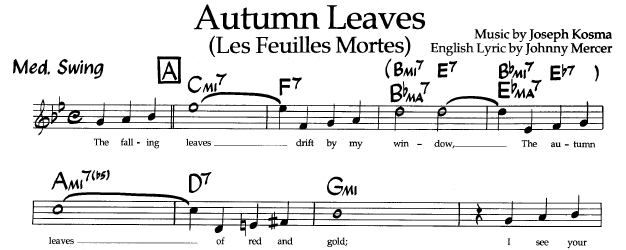
The first thing we have to do is learn to play the chords and melody. As this lesson is concerned with developing improvisational skills we will not be talking about harmony. So there will be no discussion of voicings, or substitutions, or anything of the like. We will assume you can already play the harmony and melody of a song and build from there.
How to Develop Your Improvisation
In order to concretely show how to develop your improvisation skills I’m going to break the process into 10 steps or ‘levels’ – with level 1 being really basic, beginner soloing; and level 10 being much more advanced and complex improvisation. Further, we will consider 6 different elements of ‘improvisation’ separately. These are:
- Some kind of ‘base’ collection of notes (like the melody or a scale) which will serve as our anchor and from which we will explore;
- Additional improvisational techniques or scales which we will add on top of our ‘base’;
- The phrasing we will use;
- The rhythm we will use;
- Any particular notes that we will target;
- And the overall ‘sound’ we will create.
So let’s begin.
Level 1: So we have learned the chords and the melody of our song. At level 1, we will be improvising by just using the melody of the song and embellishing it. We can add ornamentation, and add fills over long notes or long rests. For example, in Autumn Leaves there are long notes in bars 1, 3, 5 and 7. So we will be playing a short and simple phrase during and in place of those long notes. We will primarily (though not necessarily) be using the Bb Major scale to improvise and using a smooth, even swing rhythm. So first play the melody, then instead of holding the long note (Eb), play a few notes from the Bb Major scale, then return back to the melody, and so on. This is our first improvisation. And our little phrases in between the melody can use any of the 12 notes (including ‘wrong’ notes outside of the Bb Major scale). Because we will always be returning back to the melody we will be creating tension with the ‘wrong’ notes, and resolving it when we return to the melody.
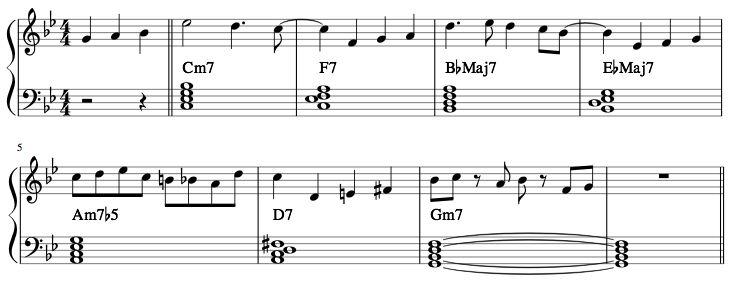
Level 2: Here we will just be arpeggiating the 7th chords of the progression (so start by arpeggiating a Cm7 chord, then a F7 chord, and so on) using melodic continuity (a constant rhythm of swung quarters or triplets). Continue playing with a smooth swing rhythm.
Aside: Melodic continuity is a great way to practice improvisation because it forces you to think fast. You can’t stop and think, you have to just keep going, plough through and recover from any mistakes. This is a very important skill to have.
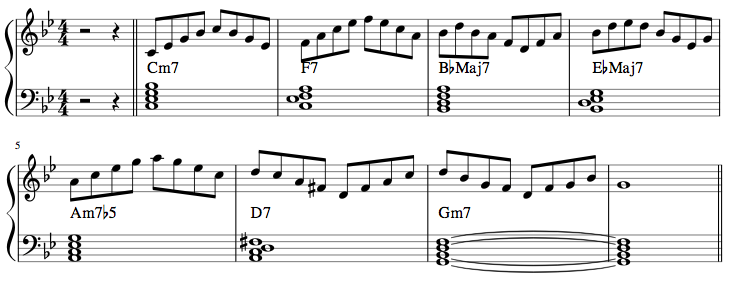
Level 3: Next we will be using the relevant diatonic scale (Bb Major) to improvise over this progression. Continue using melodic continuity and an even swing rhythm. Just run up and down the Bb Major scale occasionally changing direction. This sounds like we are just playing scales or exercises rather than improvising, but that’s kind of the point. We are just getting used to the sound of the scale over the chords.
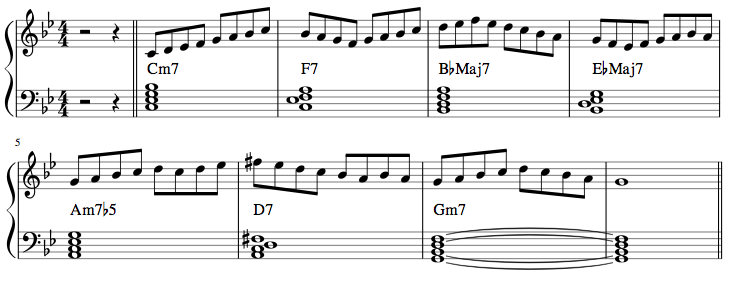
Level 4: Now we will continue using the Bb Major scale but instead of just running up and down the scale (by step) we will also introduce skips and leaps to make our improvisation a bit more interesting (but still only using the Bb Major scale).We will continue using melodic continuity, but this time instead of playing a nice smooth swing rhythm, create a syncopated rhythm by accenting at irregular times (both on and off-beats). Further, rather than playing any random note at any particular time, try to play a Chord Tone (root, 3, 5 or 7 of the chord) on beat 1 of each bar. This is a little bit tricker now as you have to pay attention to what chord you’re currently on and what note you are playing. So now we have to think about one aspect of rhythm (the syncopation) and the notes we are playing (targeting).
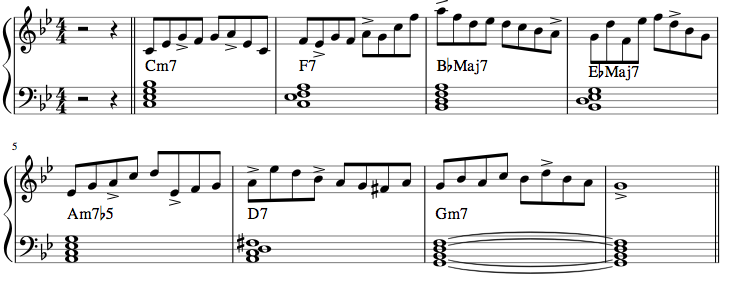
Level 5: Here again we will be using the Bb Major scale, but rather than using melodic continuity we will instead create short phrases consisting of 3-5 notes (varying the duration of your notes). After playing a short phrase we will pause for a moment, then play another short phrase, then pause again, and so on. And try to end each phrase on a guide tone (3rd or 7th of chord). Further, try to use some repetition and call & response in your solo. So here we have to think about two aspects of rhythm (both the duration of the notes, and the accenting of the notes), the notes we are actually playing, and the phrasing.
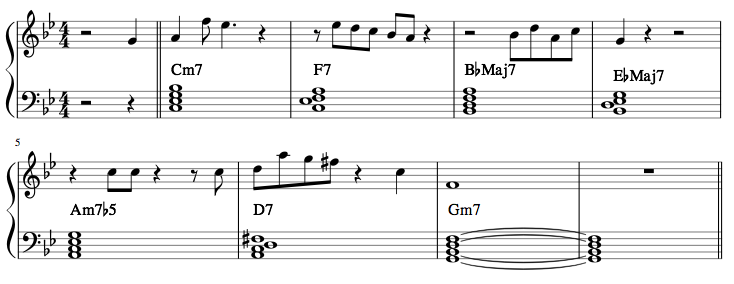
Level 6: Here we continue using the Bb Major scale, but we will begin introducing some ‘outside’ notes (notes outside the Bb Major scale) in the form of some simple improvisation techniques, namely:
- Chromatic passing notes,
- Chromatic runs,
- Side-slipping, and
- Cycled patterns.
These outside notes will create some tension which we will then resolve by returning to the Bb Major scale. This time play medium length phrases of 6-12 notes, continue to end each phrase on a guide tone, and syncopate your rhythm. Here we are now thinking about two aspects of rhythm (the duration of the notes, the accenting of the notes), the notes we are actually playing (both inside and outside the Bb Major scale), and the phrasing. Up until this point, our overall ‘sound’ has been purely diatonic – i.e. we are primarily using the Bb Major scale with some chromaticism at this currently level.
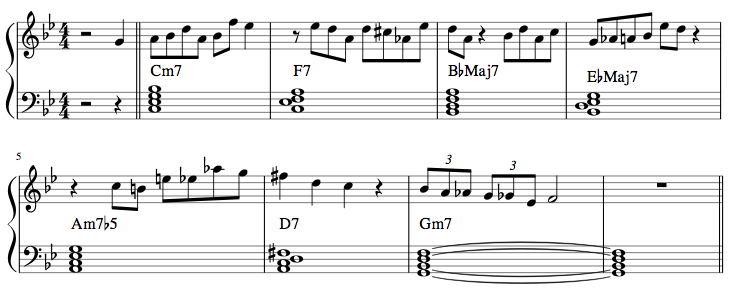
Level 7: Now, instead of using the Bb Major exclusively, start using other applicable Major scale modes. One suggestion is shown below:
- Cm7 – C Aeolian (Eb Major)
- F7 – F Mixolydian (Bb Major)
- BbMaj7 – Bb Lydian (F Major)
- EbMaj7 – Eb Ionian (Eb Major)
- Am7b5 – A Locrian (Bb Major)
- D7 – D Mixolydian (G Major)
- Gm7 – G Dorian (F Major)
Use longer phrases of greater than 12 notes, and continue using a syncopated rhythm. This time instead of finishing each phrase on a guide tone, finish each phrase on an available tension (9, 11 or 13). This will sound much more jazzy and create a very slight dissonance against the chord. And instead of using pure repetition, use motivic development. This is where we take a phrase, the repeat the phrase but with a slight change (either in pitch or rhythm) and thus ‘develop’ a similar sounding but slightly different phrase. We are now thinking about two aspects of rhythm (the duration of the notes, the accenting of the notes), the notes and scales we are actually playing (various modes), the phrasing, as well as creating and developing little motifs – so as you can see this is getting rather more complex. Because we are using Major scale modes, we are creating a more polytonal sound. The chord progression is in the key of Bb Major (or G minor) but we are using modes derived from lots of different Major scales over the top.
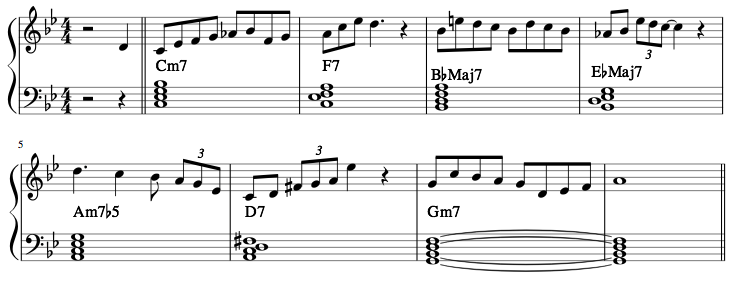
Level 8: Jazz arose out of a combination of Ragtime and Blues music. As such, the language of the Blues is very much incorporated into Jazz. For this reason, we should practice improvising using the blues scale (in this case the G blues scale). Continue creating longer phrases, finish each phrase on the root note (1) or a blue not (b3, b5, or b7; so Bb, Db, or F), use a syncopated rhythm, and try to incorporate some call & response and some nice blues licks into your solo. This, naturally, gives us an overall blues sound.

Level 9: Now we’re going to branch out a bit. Instead of using the Bb Major scale, or even modes derived from the Major scale, we are going to use more exotic scale to improvise over the progression. One suggestion is shown below:
- Cm7 – C minor pentatonic
- F7 – F Wholetone
- BbMaj7 – Bb Lydian Augmented (G melodic minor)
- EbMaj7 – Eb Lydian Augmented (C melodic minor)
- Am7b5 – A Half diminished scale (C melodic minor)
- D7 – D H/W Diminished
- Gm7 – G Bebop Dorian
This time use irregular phrases (phrases typically last one, two or four bars. We call these ‘regular’. Thus ‘irregular’ phrases last a number of measures other than those just mentioned. For example, an irregular phrase could last three, five or six bars), start and end phrases at unusual times (like 1/3 of the way through a bar), use irregular rhythms, and finish phrases on either a guide tone or an available tension (alternate between the two). We are now thinking about two aspects of rhythm (the duration of the notes, the accenting of the notes), the notes and scales we are actually playing, as well as phrasing. Because we are using exotic scales now, we are creating a much more chromatic sound.
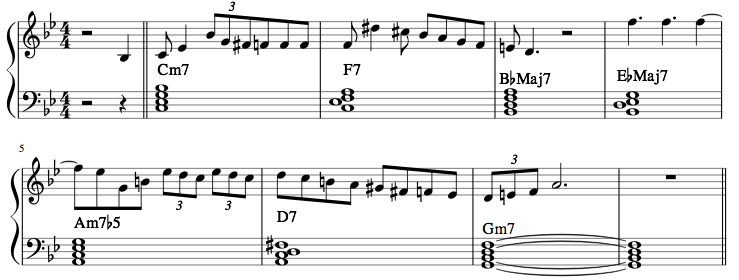
Level 10: Finally, we will be using the chromatic scale to improvise (i.e. all 12 notes). Here we can use any type of phrasing (short, medium, long, regular, irregular), try to create polyrhythms, and use improvisation techniques such as superimposition (where you superimpose a completely new chord progression over the existing one). While improvising, instead of creating and resolving tension, try to create and then fail to resolve tension. This can be done by finish each phrase on an avoid note, or using tone clusters.
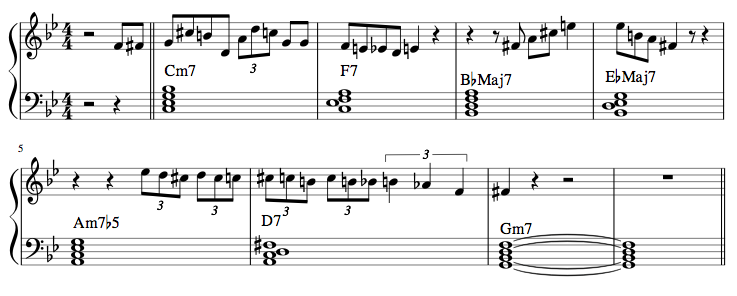
Below is a table summarising the steps involved in developing your improvisation.
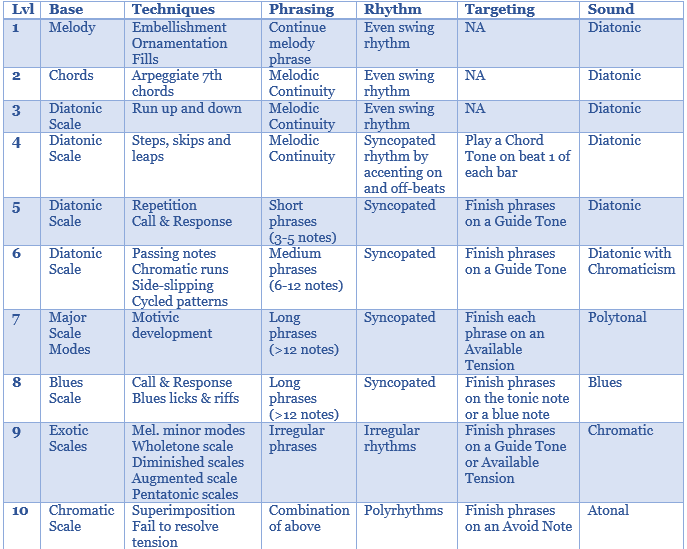
Mix & Match
The final couple of levels are going to sound very chromatic and atonal and unpleasant. But that’s ok, indeed that’s the point. Treat the above levels as a learning exercise. We started with a really simple basic improvisation and we’ve slowly added more and more complexity until we got something really quite chromatic and dissonant and complex; both rhythmically complex and harmonically complex and melodically complex.
I’m not trying to tell you that level 10, the really chromatic, jagged, angular, horrible sounding improvisation, is better or more jazzy than your than level 2 or level 4 or level 6. This is really just for practice. You should be relatively comfortable playing at all these different levels of complexity (from clean diatonic to rough atonal) and on the spectrum in-between, because ultimately the idea is not to sit at one particular level through your entire improvisation but to pick and choose and mix together all these different techniques and levels of dissonance and complexity into a holistic, nice sounding solo. So your solo can start diatonic and simple, but then you can chuck a little bit of atonality in there, and a little bit of Blues, then a wholetone scale, and some side-slipping, etc.
The way I like to think about improvisation is that we start with a base scale (a scale that fits over most or all of the chords – which is our Bb Major scale in this case) and from this base scale we pivot back and forth between different exotic scales, improvisation techniques, tension levels, etc. In this way you can actually create quite an interesting and complex sounding solo that’s intuitively quite simple.
Having an improvisation that only uses the diatonic scale (like levels 1 through 5) will sounds quite boring, and having an improvisation at level 10 the whole time will also sound horrible. But by mixing in and pivoting between the two extremes you can create a really nice sounding improvisation. And the base scale acts as our anchor or reference point. Whenever you get lost or make a mistake, retreat to the base scale.

As I mentioned at the beginning of this lesson, we’ve just been using really simplistic harmony through this lesson – just basic 7th chords. In reality, when performing you’ll want to use some more interesting and sophisticated harmonic techniques including voicings, substitutions, etc. But that’s a whole other story.
So by following the above steps you should gradually be able to build up and develop your improvisation from a simplistic diatonic solo to something much more complex and advanced. Next, all you need to do is practice – for a few hundred hours.